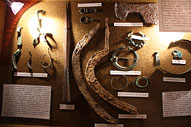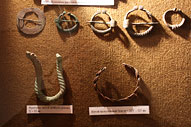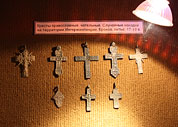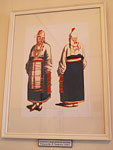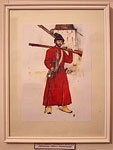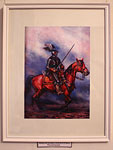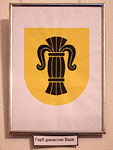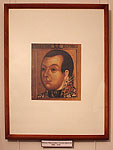In the 12th century the rich and populous area between the rivers Luga and Izhora became an inalienable part of the Novgorod State. Ancient Vodskaya and Izhorskaya lands had always borne strategic importance for the republic. Here the most fertile soil of the North-West was to be found. The area also contained the water route from the Baltic Sea to the Ladoga lake and the river Volhov along the river Neva which was indeed a vital artery of the medieval Novgorod. As of the very beginning the population of this region was diverse: here the Slavs lived cheek by jowl with Finnic tribes of Votes, Izhora and Narova. “Slavic neighbours had a strong influence on the Finns, and a good one”, wrote N.K. Roerich in one of his articles. Abundance of Novgorod style stone crosses dating back to 14th-15th centuries is one of the evidences of this influence.
Ingria and Watland were situated near the border. In the first half of the 13th century Novgorod’s bellicose neighbours – the Livonian Order and the kingdom of Sweden laid claim on them. For several centuries Novgorod, first on its own and later as a part of Muscovite Russia, successfully repelled attacks of the knights, from time to time countering them with heady returns. It was one of these returns that put an end to the Livonian Order, that was destroyed in 1559 by troops of Ivan the Terrible. Sweden became the main opponent to Russia in the North-West. For a short period it even managed to occupy the Izhora land of Ingermanland (1580-1595).
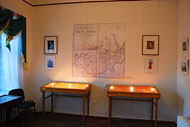 |
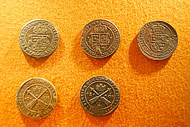 |
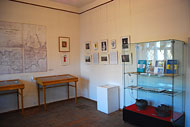 |
| General view of the exhibition |
Various types of "1 öre" coins |
General view of the exhibition |
| | 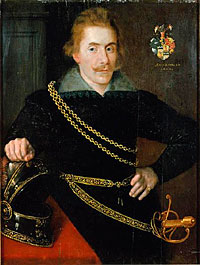 |
| | Jacob Pontusson De la Gardie
1583–1652 |
Following the death of Ivan the Terrible and a feeble and unsuccessful reign of Boris Godunov, the Great Revolt broke out in Russia that lasted from 1598 till 1612. Weakened by the civil war, pushed to the break, the state was not in power to provide safety of its borders. Swedish corps under the command of Jacob Pontusson De la Gardie, invited by Vasily Shuisky's government to counteract the army of the impostor False Dimitry II, soon started an open intervention on the Novgorodian land.
The weakened Russian state faced one of the best European armies of that time, headed by a wonderful commander. In 1611–1612 De la Gardie's troops captured fortresses of Yam, Ivangorod, Koporie, Ladoga, and Oreshek – all key points of the region. Even Novgorod itself fell under Swedish occupation. In 1617 as the result of peace talks so called "Treaty of Stolbovo" was signed, according to which Ingermanland was transferred into the possession of the Swedish crown.
For Sweden it was a resounding success. When making a speech in Riksdag, King Gustav II Adolphus said upon the subject: "Lord has shown Sweden his great mercy by the fact that the Russians, with whom we used to live of yore on indefinite conditions … now have to leave forever the brigands' nest from which they used to disturb us so often… Russia has been deprived of the sea".
Sweden came into the possession of rich lands. According to the conditions of the peace treaty, local population should have stayed in their houses and under the power of the Swedish crown continue to live as before. But people of orthodox belief did not wish to live under a protestant king and a new church. Massive exodus started from Ingermanland to the Moscow realm. The lands, ravaged by a train of wars, were almost completely depopulated.
German colonists from the Baltic region, which politically was subjected to Sweden, were invited to come and live in the lands. Also Finnish peoples of Evremeiset and Savakot from the south-eastern Finland and Vyborg Karelia came there. That is how Ingrian Finns, those who later made up the biggest part of the population of the province, came into existence.
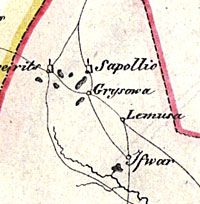 | |
| A fragment of a map drawn by Berenheim, based on the Swedish maps of Ingermanland of the 17th century. Pokrovsky Pogost. Villages Ozertitsy, Zapolie, Gryzovo, Lemozha and Izvar. | |
The Swedish had kept the previous division of the region into uezds and pogosts, only they started calling uezds by a more habitual word for them - "Län". Like in the time of Moscow reign Ingermanland consisted of 4 of such uezds-läns: Koporsky, Yamsky, Ivangorodsky and Orehovetsky, with the centres in towns of the same names. There were also Korelsky län with the centre in Korela-Kexholm (modern town of Priozersk) and Vyborg Castle län. Läns were divided into pogosts. Thus, we would now have been in Izvar settlement (Izvarhoff) of Ozersky pogost of Koporsky län.
It was the Swedes who started making a topographic map of the region and were extremely successful in it. The art of cartography in Sweden at that time was one of the most developed in Europe and the most precise maps drawn by the royal surveyors remain an important historic source, that allow to study various processes and phenomena.
In the middle of the 17th century new villages with unusual Finnish names, numerous farmsteads and hamlets appeared in Ingermanland. In the same time a lot of Lutheran churches were built. However, life on the border was not quiet.
During the reign of Alexy Mikhailovich – the father of Peter the Great, Russia, strengthened after the Riot, tried to return forfeited lands and the exit to the Baltic Sea. The war of 1656–1658 was not successful for the Russian state. Neither were negotiations of 1676 and 1684. Numerous buried treasures of coins, that are found on the territory of Ingermanland, evidence of the anxious atmosphere of those years, show how unstable the situation was.
Another wave of burying treasures is connected with the commencement of the Northern War. In 1702–1703 troops of Peter the First pushed the Swedish army away from Ingermanland. Construction of the church next to the Izvara estate commemorates this event. Nicolas Roerich wrote in 1898: "In Gryzovo pogost of Tsarskoselsky uezd they say, that the appearance of this church is connected with Peter the Great, who after one confrontation or another raised a wooden cross at this place with his own hands". The church itself was constructed in 1710-s by the General Field Marshal B.P. Sheremetiev, the first owner of Izvara estate.
| | 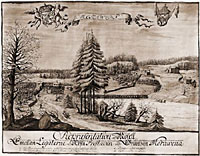 |
| | Palmkvist. "Lavskaya outpost". 1674. |
Ingermanland of the 17th century is comparatively badly studied. Nowadays there is an obvious lack of Russian language studies of the Swedish period – the final stage of the medieval period of the Izhora Elevation. An interest to this issue has increased since the beginning of the systematic archeological study of Nyenschantz – Swedish fortress in the estuary of Okhta river. For the three years the excavations there have been carried out by a St. Petersburg based archeologist P. E. Sorokin.
However the overwhelming majority of the works on Ingermanland of the 17th century are dedicated to ethnic history of Ingermanland Finns. A century-long activity of the Swedish administration, life in the estates of Swedish land-owners, twists and turns of political, economic and cultural history of Ingermanland, functioning of the Russian-Swedish border with the system of outposts, watchboxes and stockaded towns still wait to be historically and archeologically studied.
A unique exhibition "Swedish Ingermanland in the mirror of numismatic findings" for the first time demonstrates Swedish coins that were found separately, and as a part of treasures in the western part of Leningrad Oblast, that used to be Koporsky, Yamsky and Ivangorodsky läns of Ingermanland province. Household articles, copies of ancient engravings and pictures made by travelers passing through Ingermanland can create inimitable image of the époque – dramatic and bright 17th century.
The exhibition is organized within the framework of long-term museum program "Peace Through Culture", one of the projects of which is that of cooperation with Northern countries "Northern moderne. Dialogue of cultures".
"Study of the North is close and important to us, – Nicolas Roerich wrote in the beginning of the 20th century. – All details of the Scandinavian question are important to us... What is interesting in its own right becomes even more significant as a link to a bigger whole".
One of the main aims of the exhibition is to create for the viewers an inimitable image of the époque – dramatic and bright 17th century, to give a stimulus for joint Russian-Finnish-Swedish historical and archeological research as a perspective task of international cultural cooperation.
|
